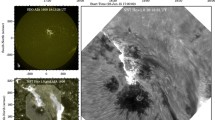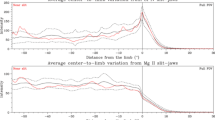Abstract
High resolution filtergrams made with a 0.3 Å K line filter at Big Bear are discussed. The dark K3 clouds noted in spectra by Bappu and Sivaraman (1971) are confirmed; they cover about 1/3 of the inside of supergranule cells, and oscillate (mainly horizontally) with 3–4 min period. Their vertical extent of about 3000 km produces a sharp broadening of K3 at the extreme limb and obscuration of bright features.
Spicules also produce K3 absorption, but they occur in emission more often than in Hα, particularly near the limb. Apart from these differences the structures seen in Hα and K generally correspond.
A fine structure of granule size, also oscillating with 3–4 min period, is seen in K1. This structure is also obscured near the extreme limb, possibly by the same clouds seen in K1.
The bright K232 network does not appear to oscillate significantly in brightness, except through covering and uncovering by the overlying dark clouds. Some bright spicules, and many dark ones, are seen over all elements of the K network, as in Hα.
In active regions the structure in K is very close to Hα; all plagettes and plages are bounded by systems of strongly inclined bright and dark fibrils apparently marking the lines of force. The fibrils are the same (bright or dark) in Hα and K3; they are not seen in K2.
Umbral flashes are much less visible in Hα. There is, however, a finer, granular umbral structure in Hα which does not oscillate. Running penumbral waves are not seen in K. The penumbra and surrounding areas are bright in K3. Every bright point in K3 corresponds to a magnetic field spot, except for the intranetwork area, where the magnetograms cannot detect possible fields. Flares are the same in K and Hα.
The formation of the K double reversal at the limb is exhaustively discussed.
Similar content being viewed by others
References
Bappu, M. K. V. and Sivaraman, K. R.: 1971, Solar Phys. 17, 316.
Beckers, J. and Tallant, P.: 1969, Solar Phys. 7, 351.
Cragg, T., Howard, R. F., and Zirin, H.: 1963, Astrophys. J. 138, 303.
Dunn, R. B. and Zirker, J. B.: 1973, Solar Phys. 33, 281.
Liu, S.: 1972, Ph. D. Thesis, Univ. of Maryland.
Liu, S.: 1974, submitted to Astrophys. J.
Orrall, F. Q.: 1966, Astrophys. J. 143, 917.
Roy, J. R. and Michalitsanos, A.: 1974, Solar Phys., 35, 47.
Sheeley, N. R.: 1971, Solar Phys. 20, 19.
Title, A.: 1968, Selected Spectroheliograms, Caltech Bookstore, Pasadena, Calif.
Tousey, R., Bartoe, J.-D., Bohlin, J. D., Brueckner, G. E., Purcell, J. D., Scherrer, V. E., Sheeley, N. R. Jr., Schumacher, R. J., and Vanhoosier, M. E.: 1973, Solar Phys. 33, 265.
Vaiana, G. et al.: 1973, Astrophys. J. 185, L47.
Zirin, H.: 1966, The Solar Atmosphere, Blaisdell, Waltham, Mass.
Zirin, H. and Lazareff, B.: 1974, Solar Phys., in press.
Author information
Authors and Affiliations
Rights and permissions
About this article
Cite this article
Zirin, H. Studies of K line filtergrams. Sol Phys 38, 91–108 (1974). https://doi.org/10.1007/BF00161827
Received:
Issue Date:
DOI: https://doi.org/10.1007/BF00161827




